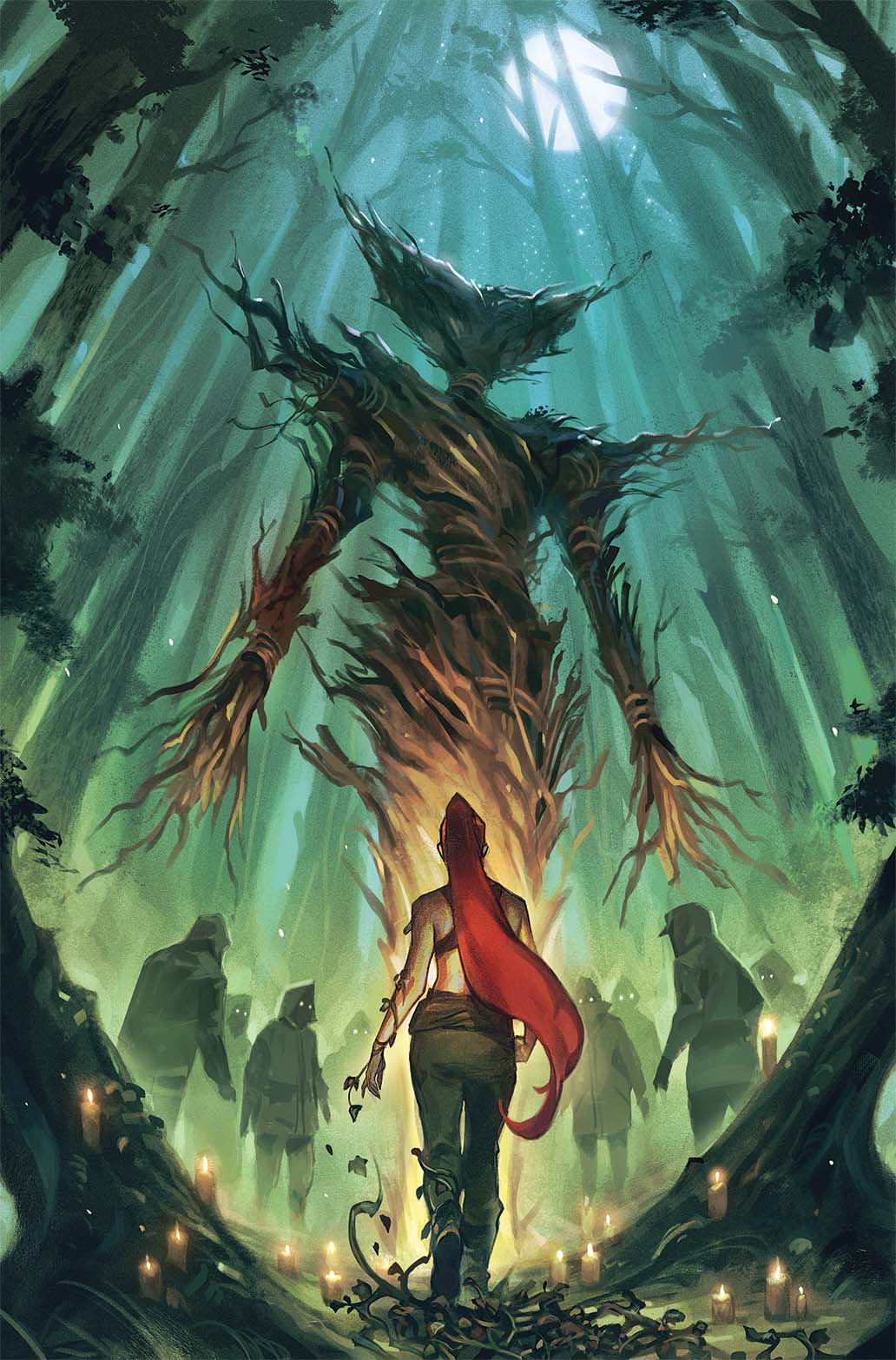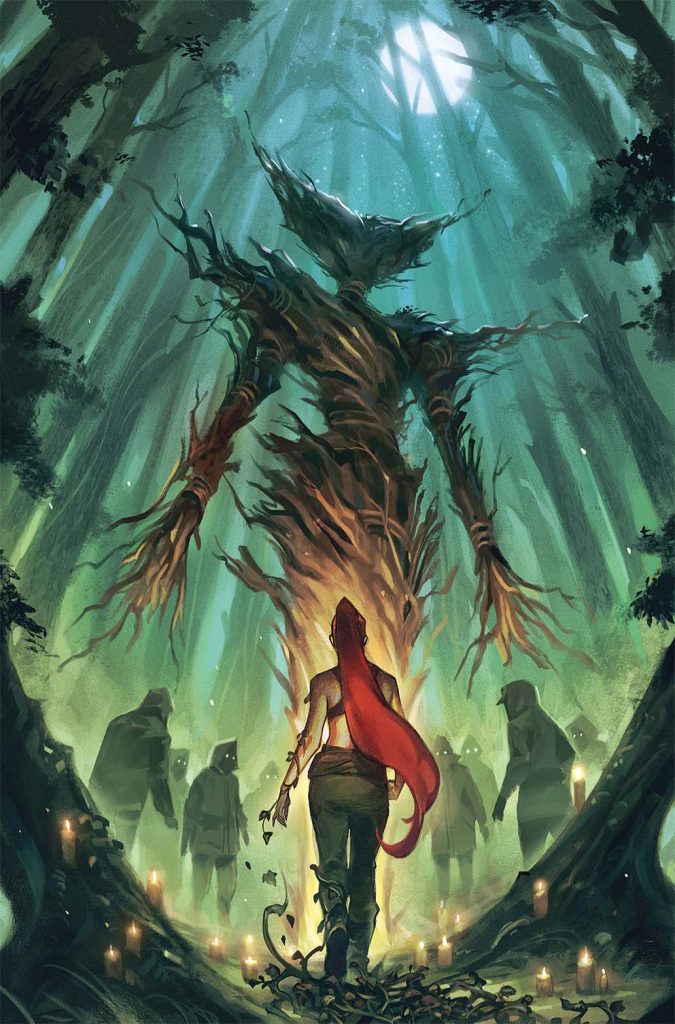In this review of Poison Ivy #29, Ivy returns to Seattle to find the first disciple of the Green Knight.
Poison Ivy #29
Writer: G. Willow Wilson
Artist: Marcio Takara
Colors: Arif Prianto
Main Cover: Jessica Fong
Variant Covers: Jenny Frison, Pablo Villalobos, Mostafa Moussa, Douglas P. Lobo, Mahmud Asrar
Release Date: January 1, 2025
This comic book review contains spoilers
The Story
Poison Ivy #29 begins with Ivy walking through the Marshlands only to find a shortcut to the city of Seattle. She’s searching for the first discipline of The Order of the Green Knight to understand the origins of a mysterious cult that has cropped up, worshipping her. In disguise, she stumbles across a meeting of The Order and befriends a member who claims to know the first disciple (with the help of her influencing pheromones). When the police try to break up the meeting, she reveals her true form: Poison Ivy AKA The Green Knight. Once the cops are handled, Ivy uses her newfound clout to demand a meeting with the first disciple.
She is led to the outskirts of town to an abandoned train car where she sees the first disciple is none other than Bella Garten AKA The Gardner (and Ivy’s former lover). Garten attempts to persuade Ivy to adopt and utilize her messianic status. She refuses and in her anger, she almost kills Garten. When she snaps out of it, she kisses Garten on the mouth before Garten attacks her and Ivy flees into the nearby woods.
Analysis
We’ve been on shaky ground for a while in this book but it’s starting to feel like writer G. Willow Wilson is finally getting back in her groove. Poison Ivy #29 dives into some pretty heady and culturally relevant topics like authoritarian cultism and the public disillusionment of peaceful progress.
Starting from the top, the scene where Ivy uses her pheromones on the male disciple is great. It’s almost as if he’s simply being manipulated by Ivy’s feminine charms but the slight green tint of his speech bubbles and his glazed over appearance convey that Ivy is using her pheromones, if only slightly. Shoutout to Hassan Otsamne-Elhaou or whoever’s idea it was to color the periphery of his speech bubbles like that. Very clever.
I’ve shouted this out before but I really dug Ivy’s narration in Poison Ivy #29. “It doesn’t matter what you’re arguing about– When you hear the word police, you are all on the same side” sounds like something Chuck Palahniuk might write. I can even hear it in Edward Norton’s voice. This whole run has given us a window into Ivy’s internal thought processes and evolution as a character in a way we’ve never seen before and it deserves credit for that. Although it has inevitably led to some internal contradictions within her world view. For example, “Zealots. Right about the problems. Deluded when it comes to solutions.” is pretty rich coming from someone with Ivy’s ecoterroism background.
Additionally, Ivy’s rejection of the messiah role here feels somewhat contrived and ambiguous. She starts with the notion that she must reject it outright on principle. She feels like this role was thrust upon her which angers her to the point of almost killing Garten. Then almost instantly, she reaffirms her belief by concluding that she’s too much of a monster to lead. What exactly does she want anymore? Clearly this run has made an effort to recontextualize her as an antihero, but to what end? Is she no longer focused on preserving the environment at all costs? Is she now willing to accept humanity’s destructive influence on the world? It’s clear Wilson is interested in telling an anti-authoritarian anti-cult story, but the hard truth is, it’s hard not to imagine a more interesting story where Ivy does take advantage of her messianic status. Maybe I’m just barking up the wrong tree (speaking of which, how about those tree dogs, huh?).
Garten’s reveal as the first disciple felt somewhat anticlimactic, I just don’t really care about that character very much. But I must admit, Garten’s passionate plea feels shockingly prescient as part of the ongoing discussion about the rising acceptance of violence as a reaction to societal issues that has been bubbling in the public sphere: “We’ve been waiting for this, Pam. Waiting for a generation that understands it’ll take more than compostable grocery bags to save this planet. A generation with nothing left to lose.”
There’s not much more I can say about Marcio Takara and Arif Prianto that I haven’t said in past reviews. Perfect, no notes. Highlights are Ivy’s attack on the police and the Bella Garten revelation, specifically the white backgrounds near the end that punctuate the conflict and give Ivy and Garten an additional subconscious disconnect in the mind of the reader.
Final Thoughts
The Order of the Green Knight story is forging an interesting path forward for Poison Ivy. Here’s hoping the payoff will be worth the investment.

